Pumping hot P-Series
ScreedPro‘s new Scania NTG P380 is pumping more than just tiling screed to building and construction sites around the country. This unique custombuilt pump truck is eliminating deadly silica dust and greatly reducing production costs and time while enhancing safety in the workplace.

Photo: Innovative mixing and pumping system means worksites are now cleaner, healthier and safer.
West Australian headquartered ScreedPro, a wholly Australian-owned company, has been supplying commercial-grade tiling screed to Australia‘s leading floor contractors and builders for more than two decades. Over the years the company has refined its technology and systems to become the preferred supplier to virtually all major construction projects in Western Australia, and is rapidly growing on the East Coast. The introduction of ScreedPro‘s first new Scania P380 and custom-built trailer a few months ago radically transformed the floor screeding industry overnight. The success of this first unit cemented the future for a total of six new Scania P380 and trailer units, scheduled to be on the road before Christmas, with a similar rollout schedule planned for 2020. Before the arrival of the ScreedPro Scania P380 and trailer pumping unit, floor screed was traditionally mixed by hand, then wheelbarrowed into the building. “There was a lot of manual handling with this process,” NSW general manager Les Stockdale explains. “To compound the problem, at high-rise job sites we were always relying on materials hoists and other site infrastructure to get to these upper levels. It was extremely time-consuming and labour intensive. Then there was the problem of storing sand and pallets of cement on-site and the risk of inconsistent mixing and quality control with hand-mixed screed.
But ultimately, there were health issues for site workers, with silica dust being the biggest problem when opening bags of cement. “Roughly 24 months ago we commenced working with a team of Australian and international engineers, along with technology suppliers, to develop a fully self-contained automatic screed mixing and pumping system,” Les says. “One of the many challenges was making the unit fit Australian ADR regulations. That‘s where Scania came to the party and became an integral partner in the development process. “These new trailer pumps are fully self-contained, sealed systems for automatic mixing and pumping of large volumes of 15 to 50 MPA screed up to 180 metres horizontally and 30 floors vertically.” Les says tilers and safety officers alike have noticed the advantages of the new unit. “Tilers can save time, cost and the effort of sourcing raw materials and manually mixing and barrowing of screed. The safety officers love our machines and process because we have eliminated high-risk manual handling and fully eliminated silica dust generation in the mixing of screed.”
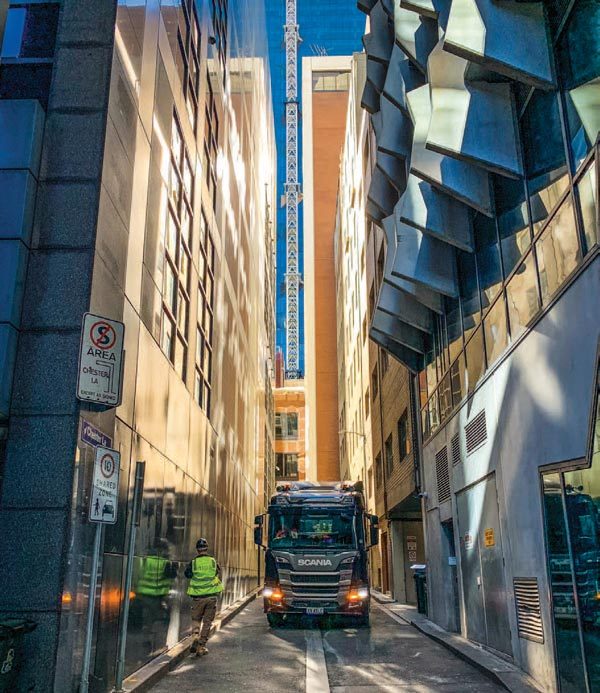
Photo: How did this get in ‘ere?
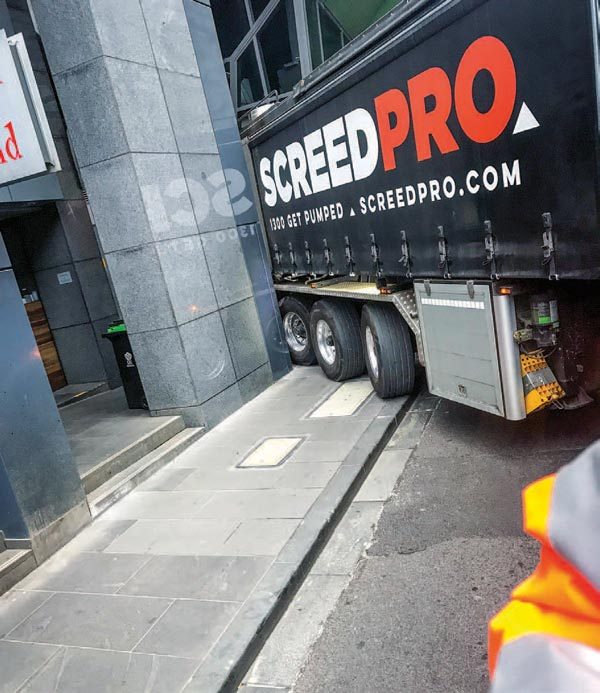
Photo: Oh, that‘s how…!
By mid-2020 ScreedPro aims to have depots in all major capital cities. Currently, the company has depots in Perth, Melbourne and Sydney. “We also service regional projects,” Les says. “That‘s the beauty of our system being truck-mounted, we can go virtually anywhere. In fact, on Sunday last week we sent one Scania P380 1000km from Sydney for a 13m³ engineered screed job on Monday. That unit arrived back in Sydney ready for an apartment project by 7am Tuesday morning. That‘s the beauty of the Scania P380‘s performance and reliability.” When selecting a truck supplier, ScreedPro looked for much more than the cheapest truck quote and wanted a transport partner who would be deeply involved in the entire technology development process and fleet rollout. Les comments that the Scania team and the P380 prime movers play a significant role in the initial and ongoing success of their operation. “All through the development process Scania has provided great assistance and not just delivered us a truck, but also a transport solution that integrated with and enhanced our pump trailer technology. “They not only look after the service and maintenance of our Scania trucks, but they also carry out all the service and maintenance of our trailers‘ road running components and they work hand-in-hand with our specially trained team of engineers who provide the technical support for our trailermounted mixing and pumping units,” he says. “Scania suggested the P-Series model to us because of its low weight cabin with exceptional visibility. It had all the comfort and safety features we wanted to provide our drivers with, like easy cabin access for urban work, with a quiet working environment and enough storage space for the odd long-haul trek. Because of the high degree of technology and automation in our system, we had a number of technology requirements which Scania were proactive about incorporating into our build-up.” The NTG P380 certainly ticks all the boxes when it comes to urban driving, which often involves many stops and starts with repeated climbing in and out of the cabin. Because the cabin entrance is low, with convenient grab handles, this operation is both easy and safer for the driver.
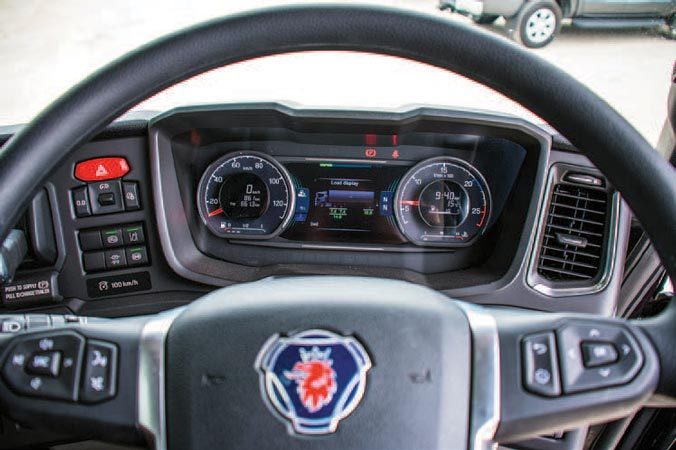 |
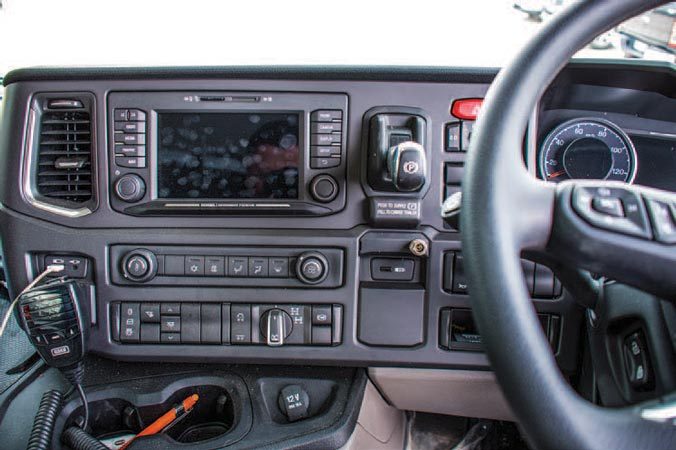 |
Photo: The NTG‘s interior is simple, elegant, and easy to operate in the best Scania tradition.
Manoeuvring around tight construction sites requires exceptional concentration and visibility and this is another area where the P380 shines. Because the driver sits high in the cabin they have an outstanding vista forward through the broad curved windscreen and rearward via the wide mirror system. The motorised mirrors can be conveniently rotated to follow the trailer by use of the multifunction mirror switch conveniently located on the driver‘s side door armrest. “There is no question the Scania P380 really is a premium workhorse,” Les says. “When you consider the ease of cabin access, incredible storage options and sleeper area, along with the optimised dashboard and on-board entertainment, life on the road for our drivers is extremely comfortable.” These ScreedPro P380 trucks are powered by the Scania D13 380hp (283kW) engine coupled to a 14-speed overdrive transmission with Opticruise shift. Manoeuvring in and around tight city construction sites is right up the Scania P380‘s alley, but manoeuvring a standardlength tri-axle trailer in and around the same construction sites is a different story altogether. However, that‘s another area the ScreedPro team worked tirelessly on. To ensure its new trailers would match the manoeuvrability of the Scania P380, they had them custom-built to exact specifications. The addition of the Groeneveld auto grease canister fitted to the right-hand leg is probably the first sign an onlooker gets that there is some special running gear in this trailer that requires regular lubrication, and that‘s what prompts a further look underneath.
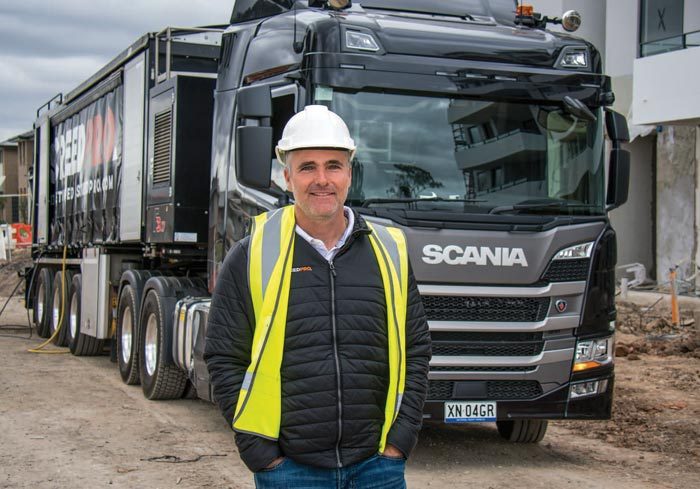
Photo: ScreedPro‘s Les Stockdale is chuffed with his new rigs.
A quick glance at the skid plate on the trailer reveals the telltale signs of Jost‘s TRIDEC hydraulic steerable suspension. The system utilises a hydraulic linkage between the fifth wheel coupling plate and axle assemblies, employing hydraulic cylinders. Besides, additional manoeuvrability can be achieved with the use of the wireless remote manual override system to get the trailer in and out of the tightest sites. BPW ECO Plus 2 axles with a pivoting hub on either end of the axle are coupled to the TRIDEC steering suspension. The use of wide 385/65 R22.5 super-single tyres on the TRIDEC suspension give the trailer a greater steering angle than if the traditional dual tyres were fitted. The trailer‘s smart braking system is a BPW-Wabco combination commonly found on many Australian-built trailers, which means parts commonality and maintenance is simplified. This innovative Scania P380 and its state-of-the-art trailer are certainly pioneering a new approach to productivity, cost reduction, quality enhancement and workplace safety in not just the building industry, but transport as well.
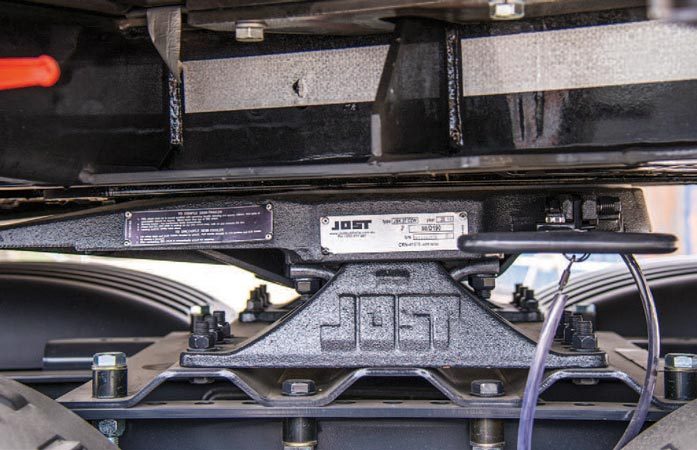 Photo: Fifth-wheel coupling plate allows the Jost TRIDEC system to rotate the trailer axles.
Photo: Fifth-wheel coupling plate allows the Jost TRIDEC system to rotate the trailer axles.
Read more
Mack Muster a must
0 Comments6 Minutes
Decks to Darwin
0 Comments1 Minutes





